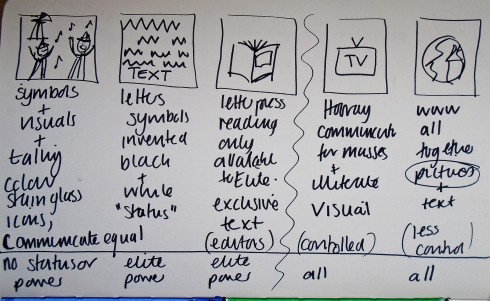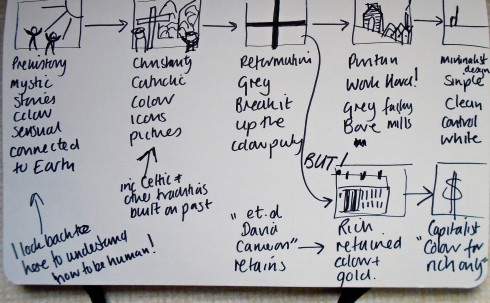

I’ve been thinking about the reformation as described by Graham-Dixon (1999) and how it relates to modern visual culture (Sturken, 1996). I made some thumbnail notes to try to summarise what happen after this period of art history and how it has influenced visual culture.
Reading about the reformation and stripping of rich vivid colour, images and statues in churches left me feeling cheated on the behalf of the people going to church, who had a rich Celtic and Catholic church visual heritage violently stripped from their lives. Their churches and society meeting places became bare of visual stimulation whilst the rich and powerful classes were able to maintain colour in their lives in private stately homes, leaving the workers in sparse less stimulating protestant or puritan churches, stripped of decoration, colour and heritage.
What has this meant for visual culture and the vast shift in the 19th century of colourful generous popular culture? We are still influenced by the protestant work ethic and the shift from visual imagery to reliance on text (Graham-Dixon, 1999). Text may spark the imagination and give ideas of colour, but only if you are literate! What our eyes actually see with text is a page of black and white (combining to make grey). Protestantism may have eventually brought literacy to the working people but it was a slow process, and in the meantime they were left in colourless churches, mills and factories. It is no wonder that television was embraced by the masses, it full of colour, stories and news/gossip. It would have been amazingly stimulating for people to feel part of something they could easily understand rather than reliance on being literate.
By developing an understanding of art history combined with visual culture it is helping me to think and understand my own pathway too, and direction to take into a more colourful world of art and imagery. I’m also reflecting back on why when I choose a culturally conventional career path I found it not as stimulating as it might have been if it had been full of images and colour. (There’s something here about the study of geology being a visual subject and the world of work I ended up in was black and white text focused.)
Here’s to more colour for everyone! Be generous with your use of it!
References
Graham-Dixon, A. (1999) A History of British Art. London. BBC.
Sturken, M. (1996) ‘Visual culture’ In Grove Art Online: 2011[online] At: http://www.oxfordartonline.com/subscriber/article/grove/art/T2093950 [Accessed 24 Feb. 2017]